

How is web personalisation affecting the news? Are we stuck in filter bubbles?
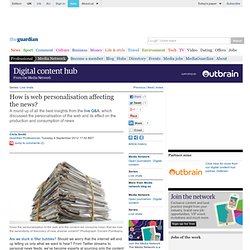
Should we worry that the internet will end up telling us only what we want to hear? From Twitter streams to personal news feeds, we've become experts at sourcing only the content that is most relevant to our particular interests, but some commentators worry that our personalised content feeds can only tell us so much of a news story. How can publishers and media organisations become more transparent in their content delivery? How can it be delivered so that we avoid 'filter bubbles' and an unbalance of news? Here are all the best views from the panel in our live Q&A on the topic of the personalisation of the web and how it affects news readers, journalists, publishers and society as a whole.
Malcolm Coles, product director, Trinity Mirror – @malcolmcoles Personalisation for publishers: I'm a big fan of personalisation. Transparency: I doubt anyone can explain the algorithms in a way we'd find meaningful. Personalization vs. Customization. Widget builder. Facebook Is Getting Into the News Business - Jeff Bercovici - Mixed Media. A new study suggests that most online readers are averse to active news personalization. Personalization is quickly becoming a key concept in the world of online news.
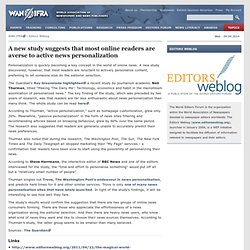
A new study discovered, however, that most readers are reluctant to actively personalize content, preferring to let someone else do the editorial selection. The Guardian's Roy Greenslade highlighted a recent study by journalism academic Neil Thurman, titled "Making 'The Daily Me': Technology, economics and habit in the mainstream assimilation of personalized news. " The key finding of the study, which was preceded by two years of research, was that readers are far less enthusiastic about news personalization than many think.
The whole study can be read here. According to Thurman, "active personalization," such as homepage customization, grew only 20%. According to Steve Herrmann, the interactive editor of BBC News and one of the editors interviewed for the study, the "time and effort to personalise something" would put off all but a "relatively small number of people". Sources: The Guardian.
A brief history of Findory. Findory was a personalized news site.
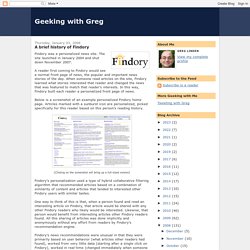
The site launched in January 2004 and shut down November 2007. News Personalization Without Registration. How News Consumption is Shifting to the Personalized Social News Stream. In honor of Mashable's five-year anniversary, this series is supported by IDG.
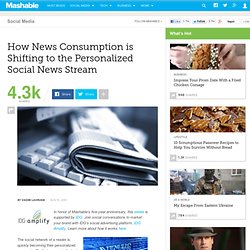
Join social conversations to market your brand with IDG’s social advertising platform, IDG Amplify. Learn more about how it works here. How you can use social machinery to power personalized news delivery. People have spent the past five years in Social Networking 101.
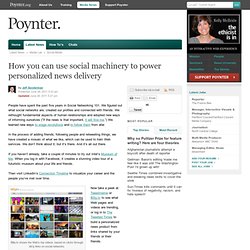
We figured out what social networks are, created our profiles and connected with friends. Panel on Future of Personalized News. Get Smarter Here. Social Networks Play a Major Part in How We Get News [STATS] The latest study from Pew Internet analyzes the news Americans are consuming and various different ways they find news.
![Social Networks Play a Major Part in How We Get News [STATS]](http://cdn.pearltrees.com/s/pic/th/social-networks-major-stats-2284417)
Based on a sample of 2,259 adults, the study reveals that three fourths of the people (75%) who find news online get it either forwarded through e-mail or posts on social networking sites, and half of them (52%) forward the news through those means. This translates to a large portion of all Americans. According to the report, 59% of those surveyed get news from a combination of online and offline sources. However, the study also shows that very few people nowadays (7%) are getting information from a single media platform.
Understanding the Participatory News Consumer. Overview In the digital era, news has become omnipresent.

Americans access it in multiple formats on multiple platforms on myriad devices. The days of loyalty to a particular news organization on a particular piece of technology in a particular form are gone. The overwhelming majority of Americans (92%) use multiple platforms to get news on a typical day, including national TV, local TV, the internet, local newspapers, radio, and national newspapers.
Profiler - Website Personalization per Visitor. Personyze behavioral targeting and personalization offers a powerful solution that allows you to quickly and easily personalize your website and provide highly targeted message/promotion/content to maximize user experience and conversion rate. Personalization is based on visitors' demographics,whether, characteristics, social profile, behavior in the website as well as, if needed, your CRM data which can be easily integrated into Personyze.
Personyze enables real time adaptation of the website’s message/promotion/content so different audience can have a completely different experience while visiting the same website. With zero-integration, personalized message/promotion/content can be automatically applied to the entire site without any resources from your IT or Design team. See examples The Personalization process using Personyze The Personalization process is a simple, fast and intuitive process anyone can perform.
How publishers are making news more personal. Advertisement With the help of new tools, publishers are finding new and better ways to personalize content for audiences that increasingly are looking for information that's most relevant to them.
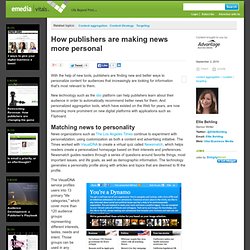
New technology such as the idio platform can help publishers learn about their audience in order to automatically recommend better news for them. And personalized aggregation tools, which have existed on the Web for years, are now becoming more prominent on new digital platforms with applications such as Flipboard. News gets personal, social, and participatory.
Americans’ relationship to the news is being transformed in several directions thanks to the new tools and affordances of technology.

Encounters with news are becoming more personal as users customize their experience and take charge of the flow of news into their lives. News is becoming a shared social experience as people exchange links and recommendations as a form of cultural currency in their social networks. And news is becoming a participatory activity, as people contribute their own stories and experiences and post their reactions to events. This chapter explores these changes in more detail. Zite delivers personalized news to your iPad. There are many, many newsreaders available for the iPad, but entrepreneur Ali Davar said his startup Zite is launching an iPad magazine with the content that’s most personalized to a reader’s needs an interests.
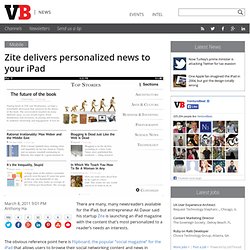
The obvious reference point here is Flipboard, the popular “social magazine” for the iPad that allows users to browse their social networking content and news in beautiful, magazine-style layout. Zite seems to combine a Flipboard-style reading experience with content personalization technology that has a similar aim to companies like Gravity and My6sense. Users can automatically create their personalized magazines by connecting either their Twitter or Google Reader accounts to the app.